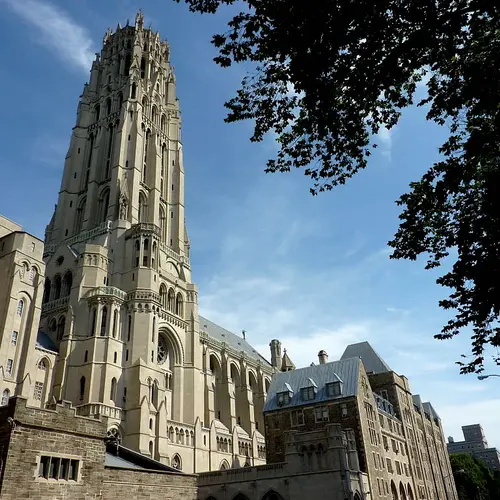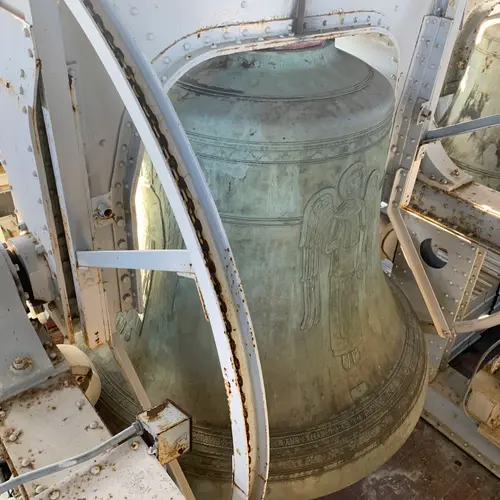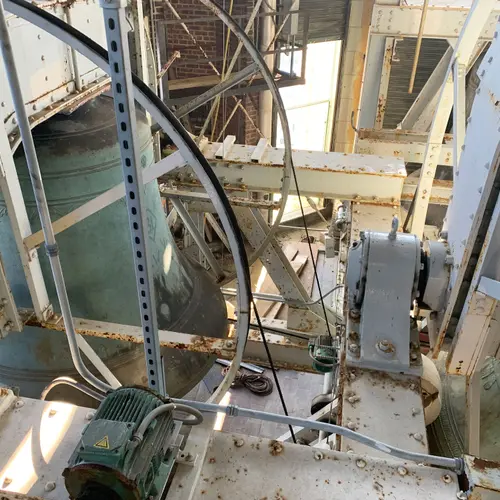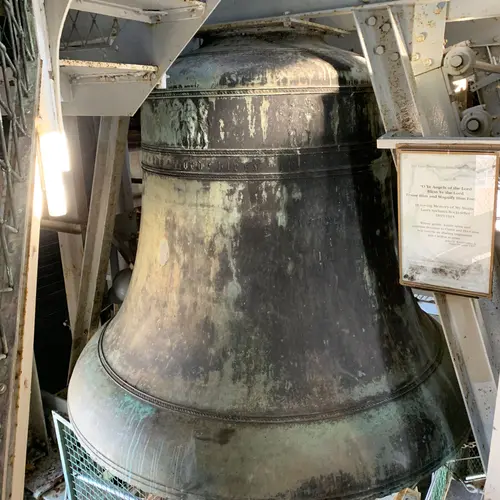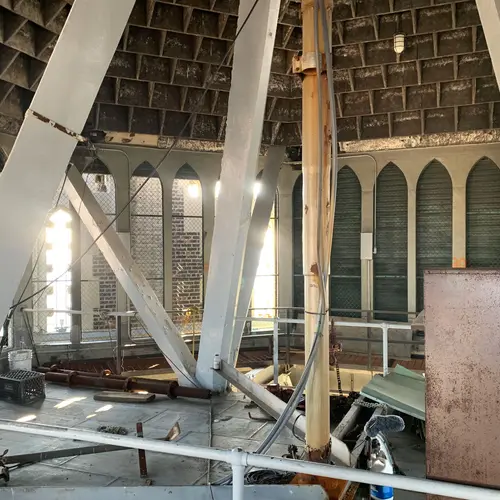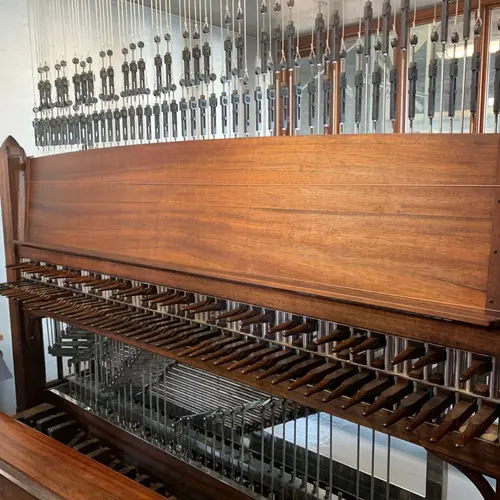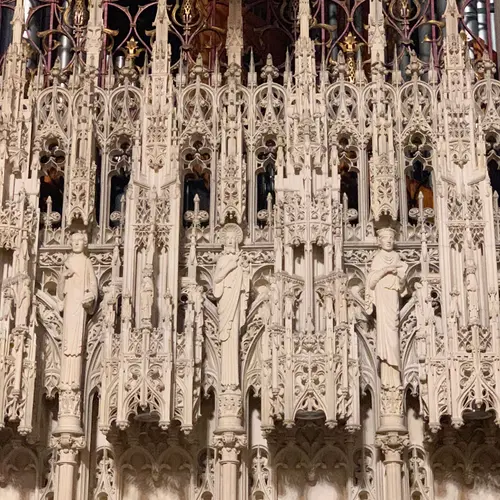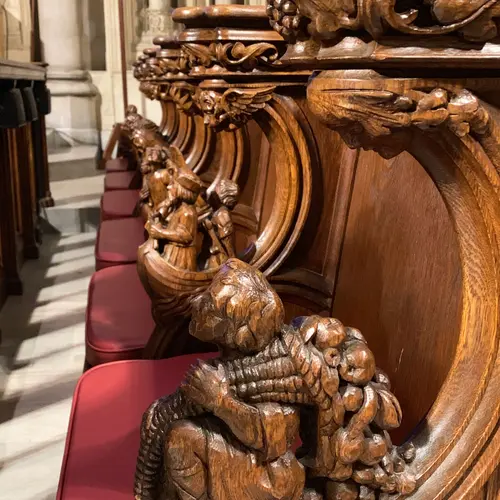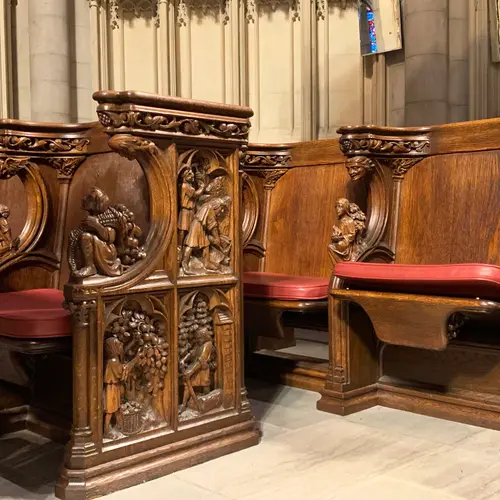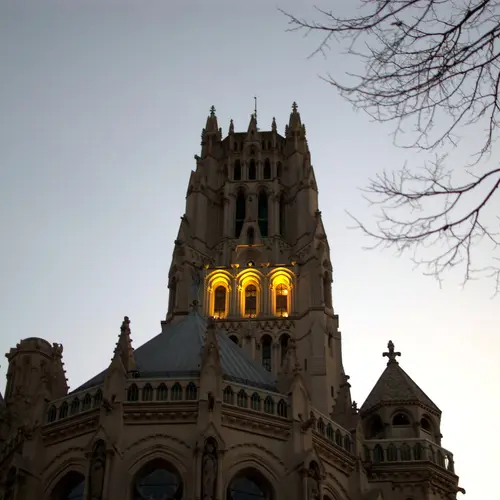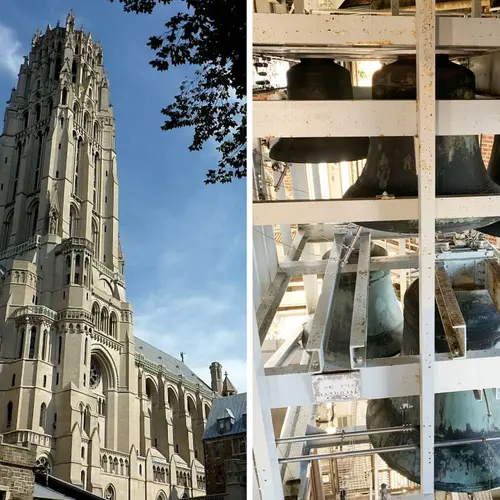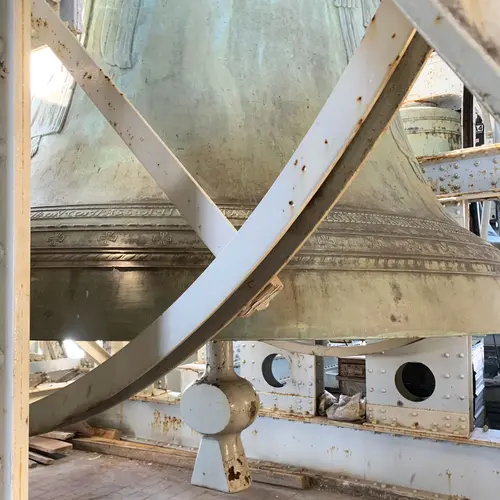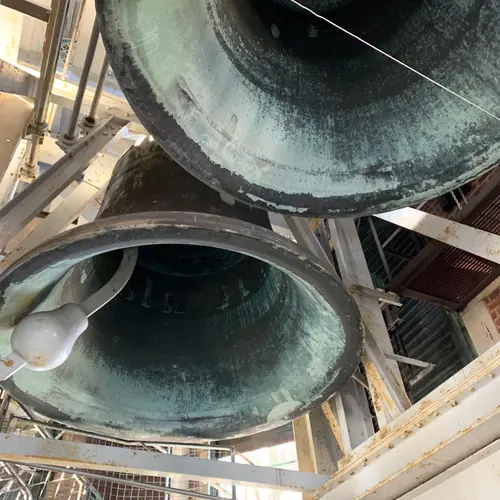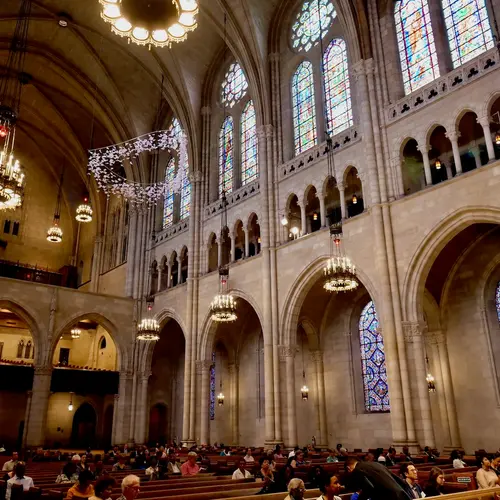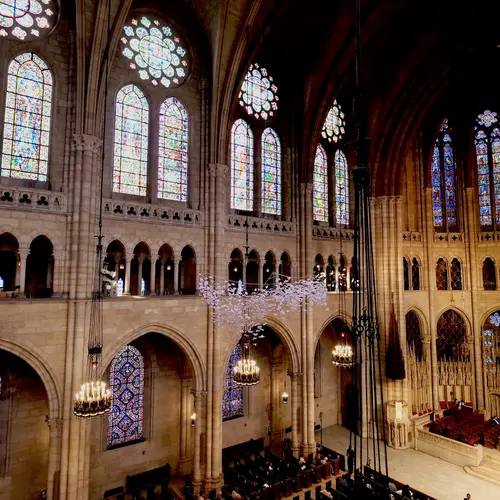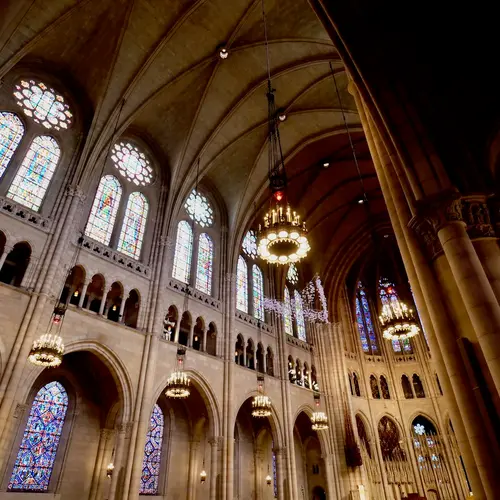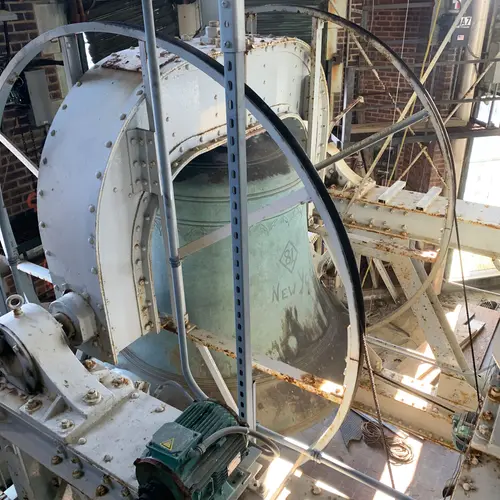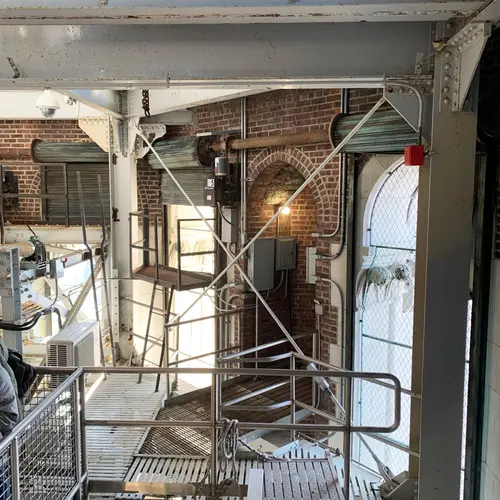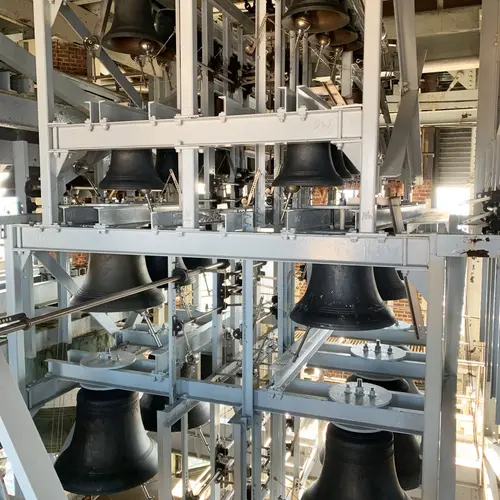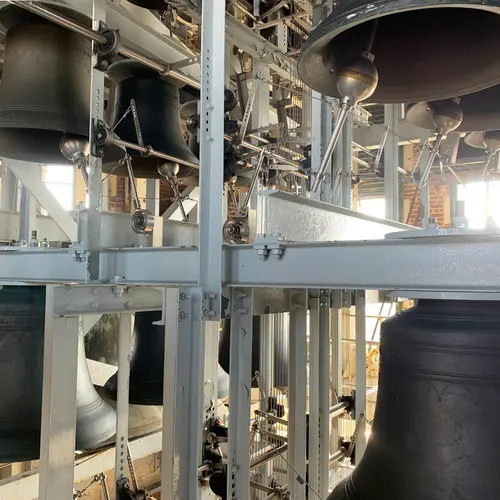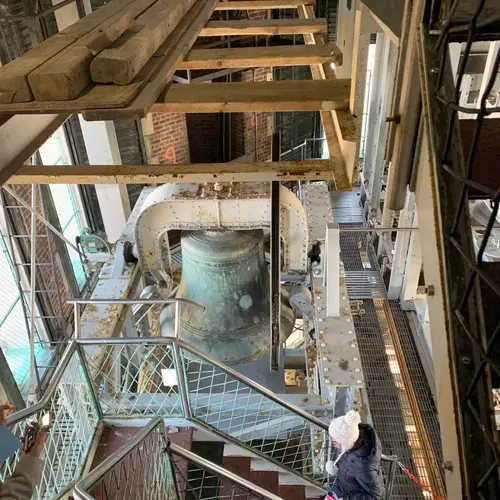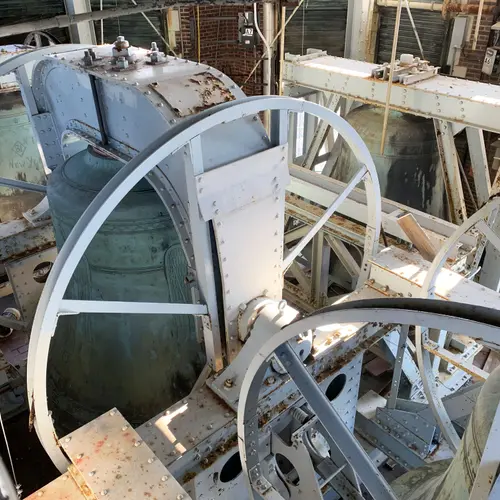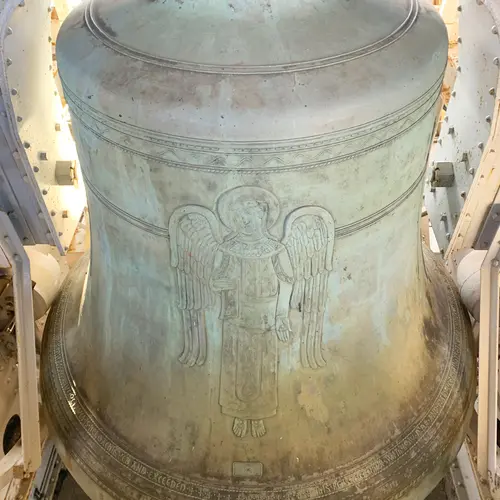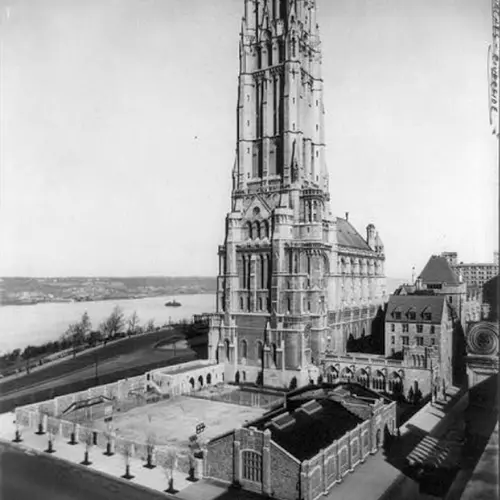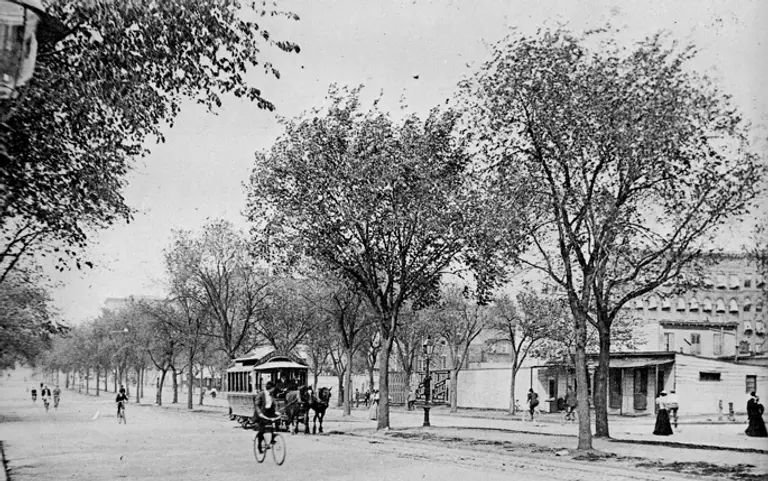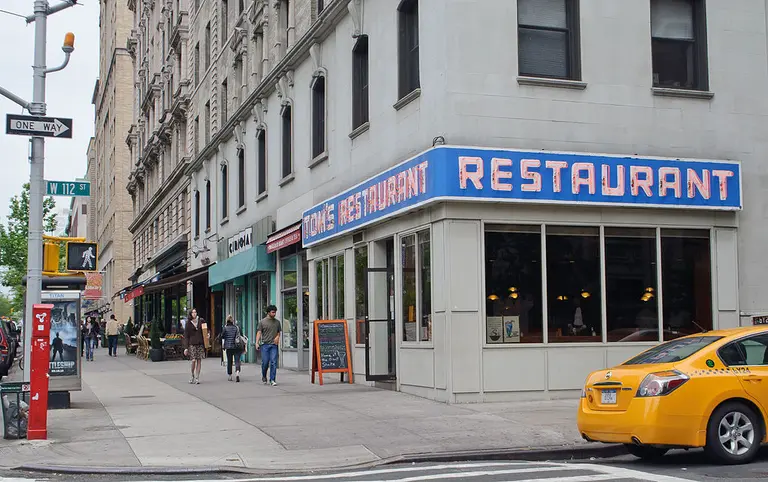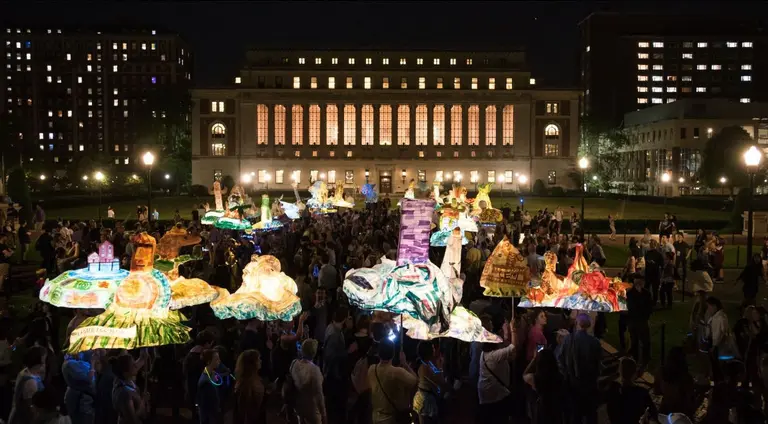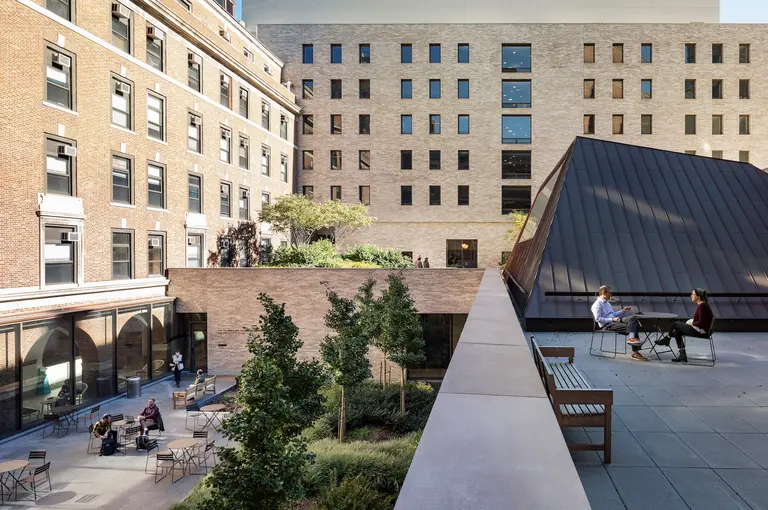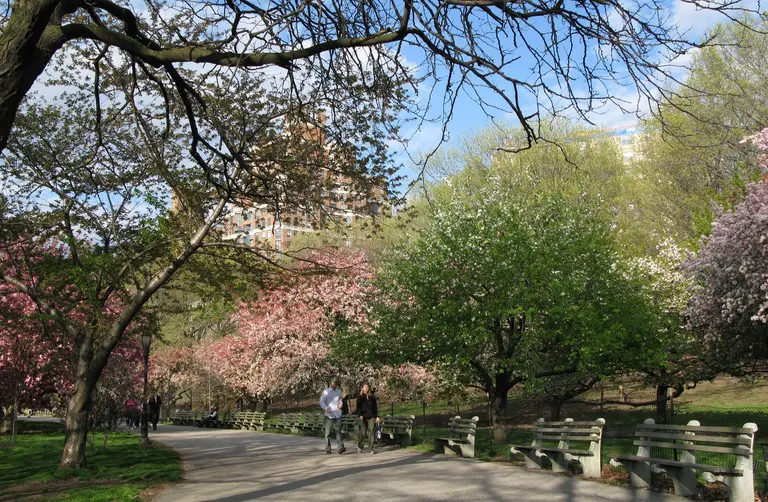Go behind the scenes at Morningside Heights’ Riverside Church and its 400-foot-tall bell tower
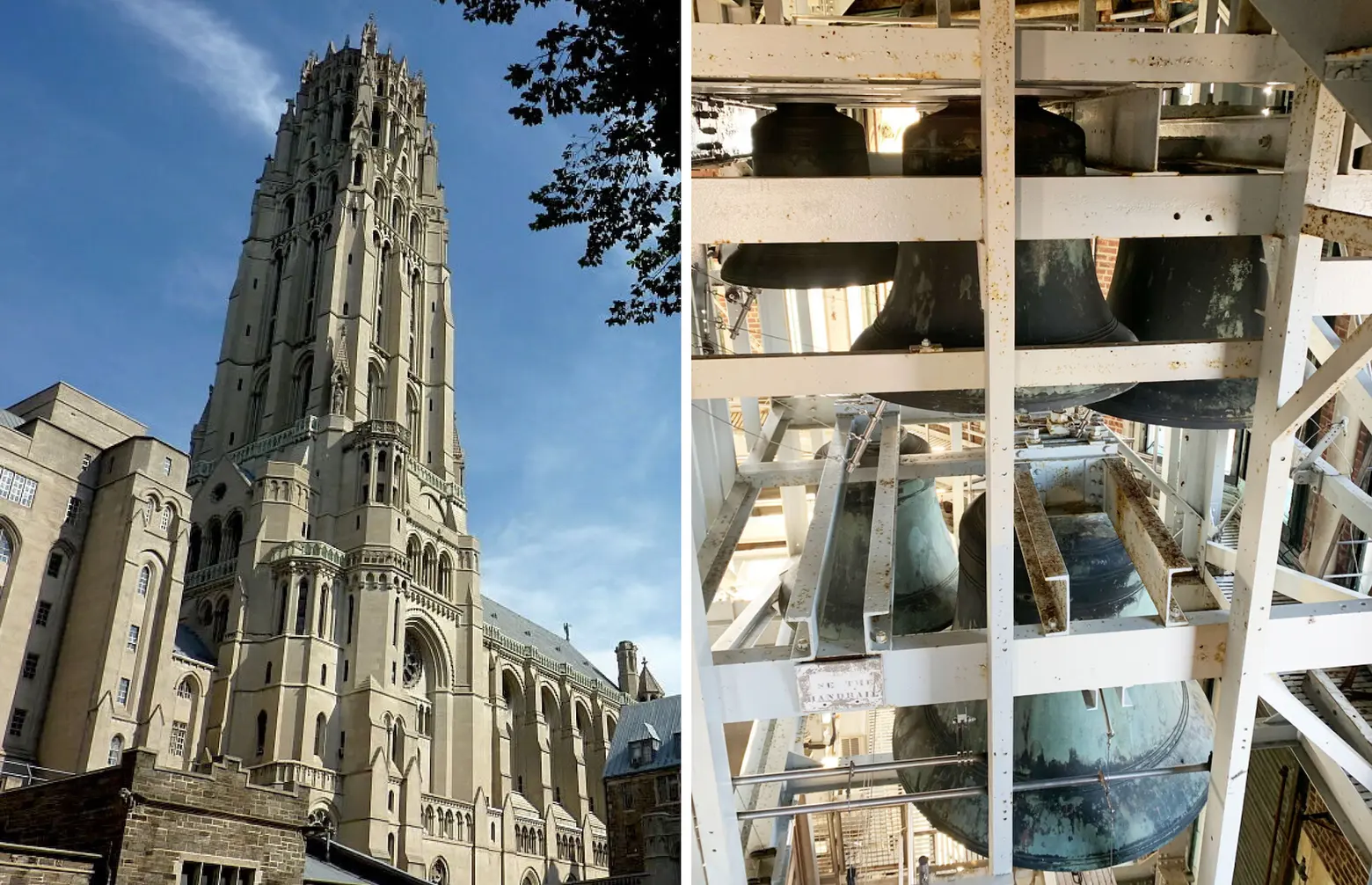
Exterior photo via Wikimedia; Photo of bell tower © 6sqft
After nearly 20 years, the iconic bell tower of the Riverside Church in Morningside Heights has officially reopened. The impressive Gothic-style cathedral is home to the 74-bell Laura Spelman Rockefeller Memorial Carillon, which includes a 40,000 pound Bourdon bell, the largest tuned bell in the world. The tower closed to the public almost two decades ago following 9/11 but reopened for public tours earlier this month. 6sqft recently took a tour of the stunning Riverside Church, known for its interdenominational services and dedication to social justice causes.
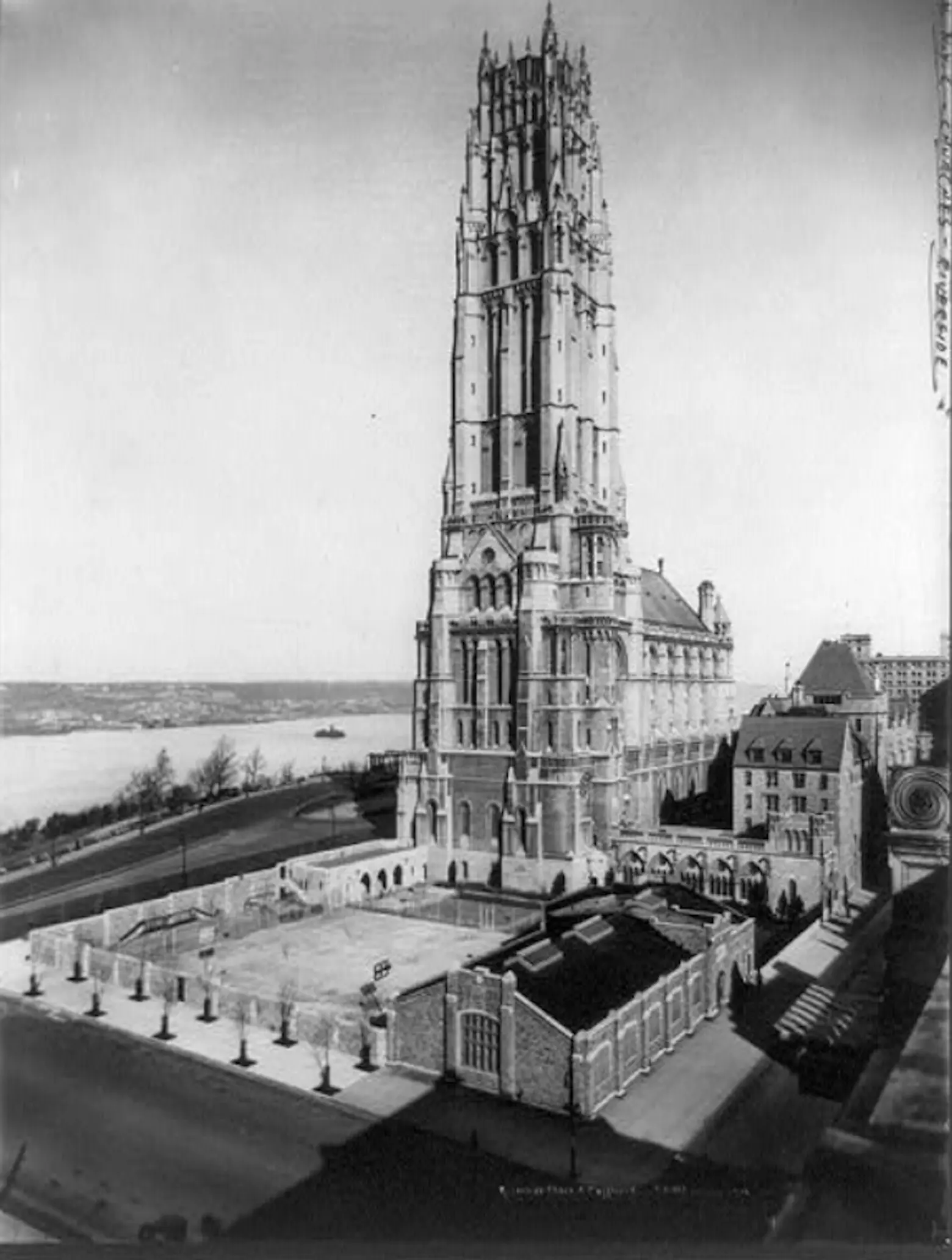
Riverside Church and playground, New York City (1936). Photograph. Retrieved from the Library of Congress
The Riverside Church, formerly the Park Avenue Baptist Church, has roots in progressive ideology. After an unsuccessful attempt by John D. Rockefeller Jr. to influence the Cathedral of St. John the Divine’s philosophy, the philanthropist decided to build a new church in the Morningside Heights neighborhood that better suited his beliefs.
With a push from the church’s founding minister Harry Emerson Fosdick, a key figure in the liberal Christianity movement, the church became one of the most significant interdenominational, multicultural churches in the country. Fosdick’s mission, which the church follows today, is to create a place that is “interdenominational, interracial, and international.”
And since its founding, the church has opened itself to those outside of the congregation. “Riverside Church will be available for service not only to its particular church family, but to the whole community,” the opening announcement from the church read, according to a New York Times article from 1930, adding, “its facilities will be available to the public every day in the year.”
Construction of the church began in 1927 on Riverside Drive and West 122nd Street. Designed by Henry Pelton and Allen & Collens, the nave of the Riverside Church was modeled after a 13th-century Gothic cathedral in Chartres, France. The 22-story structure’s exterior includes a heavy steel-frame, meant to support the incredible weight of the bells, and a facade made of Indiana Limestone.
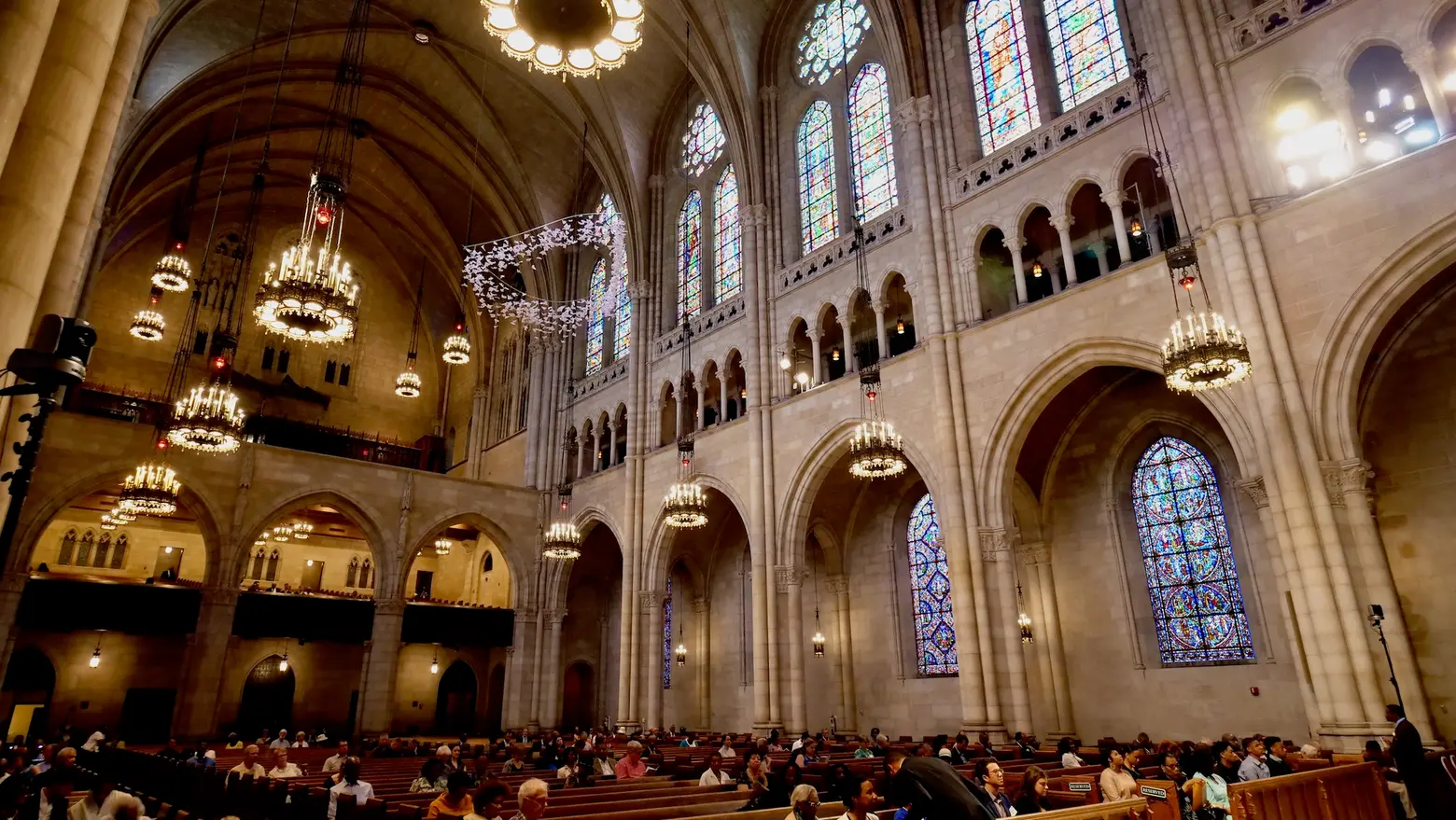
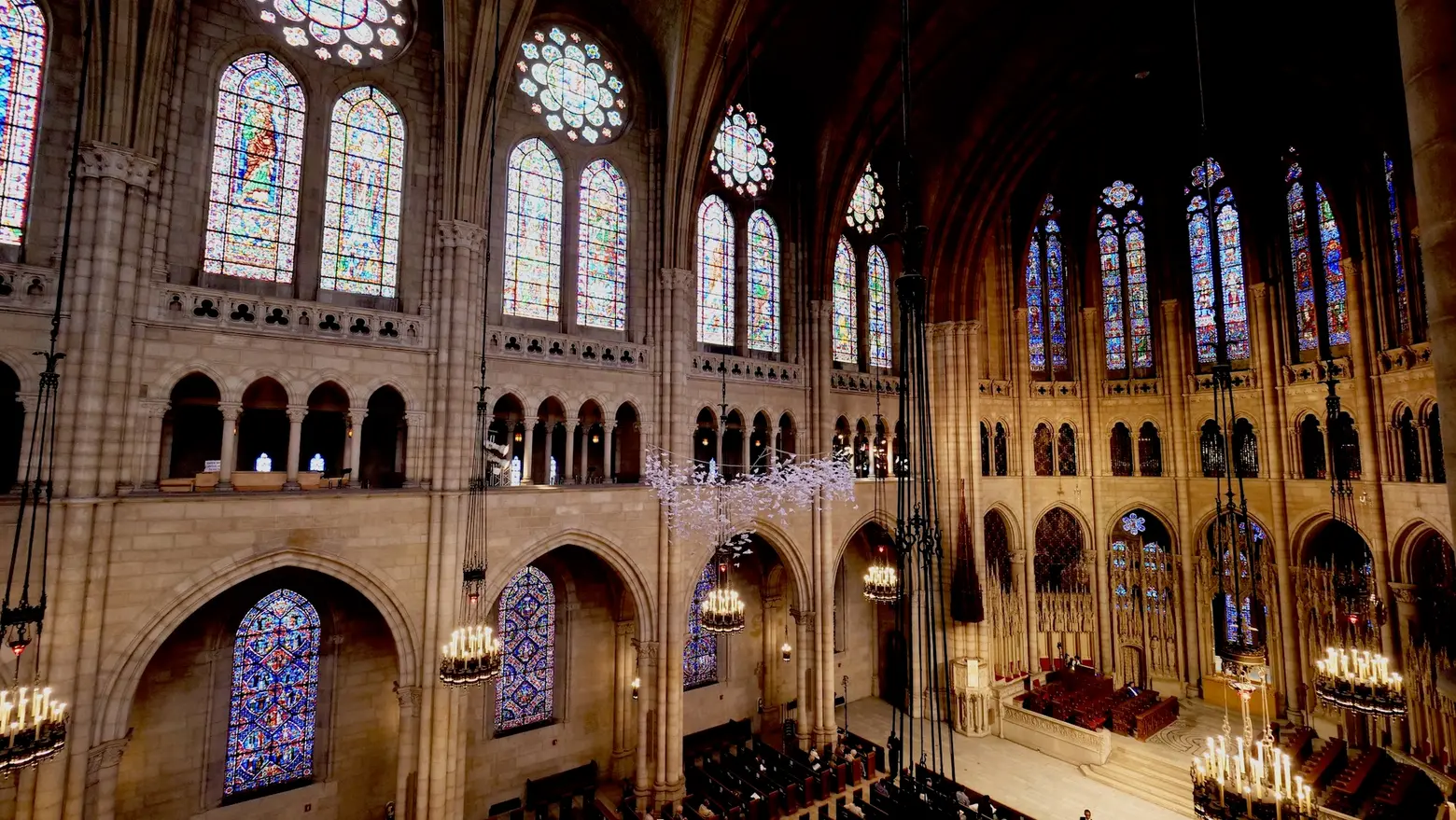
Inside the Nave sanctuary, which can seat nearly 2,000 worshippers. Photos courtesy of the Riverside Church in the City of New York
The Nave sanctuary, or the “big house” as tour manager Raymond Rodriguez called it during our visit, can seat almost 2,000 worshippers. The expansive space has nearly 100-foot-tall ceilings, a metal roof, and interiors of limestone finish with marble flooring. Plus, the vaults feature Guastavino tiles, found also at the Grand Central Oyster Bar and Grant’s Tomb.
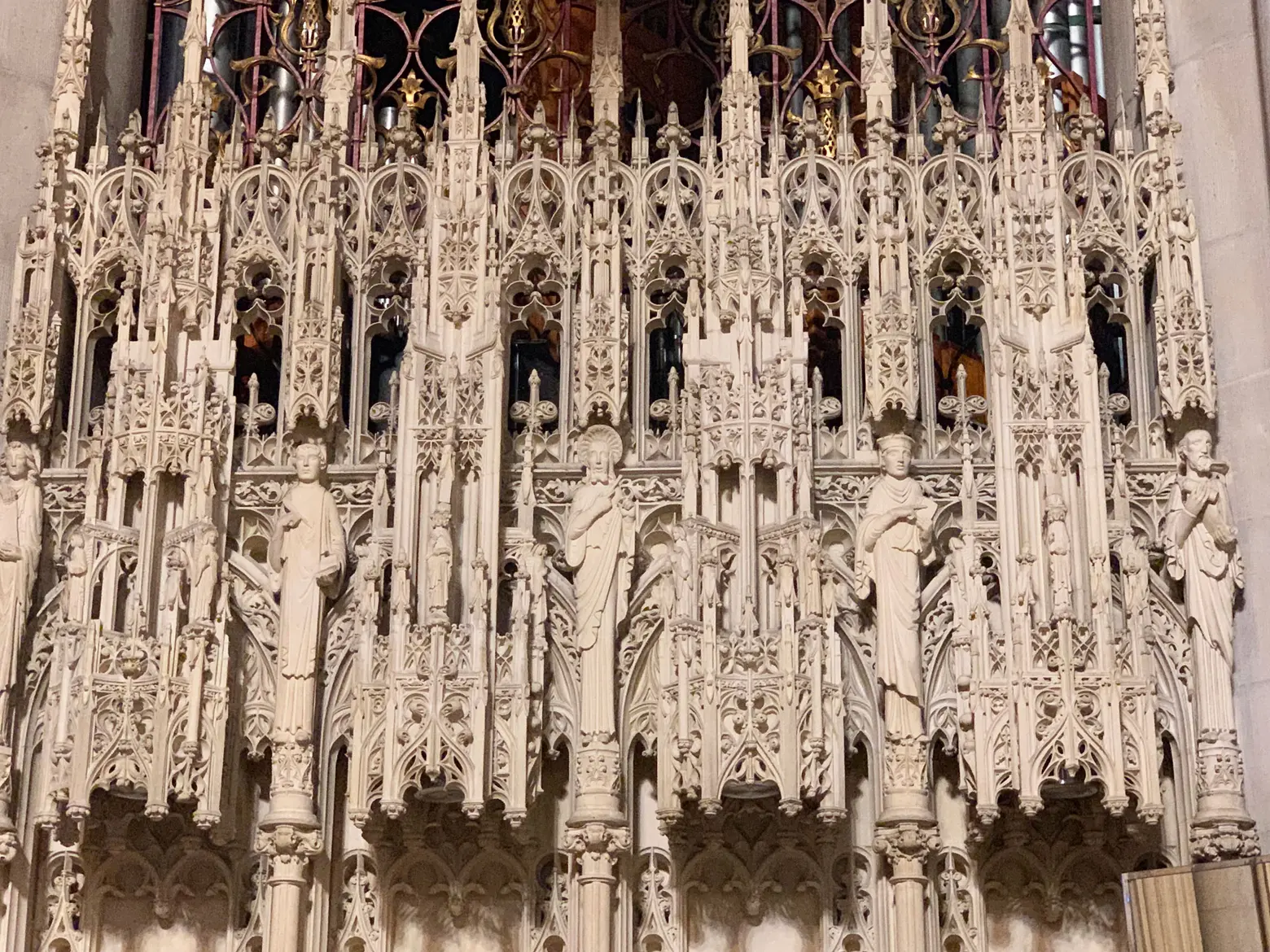
The back wall of the chancel features an ornate stone screen representing “seven phases of Christ’s ministry.”
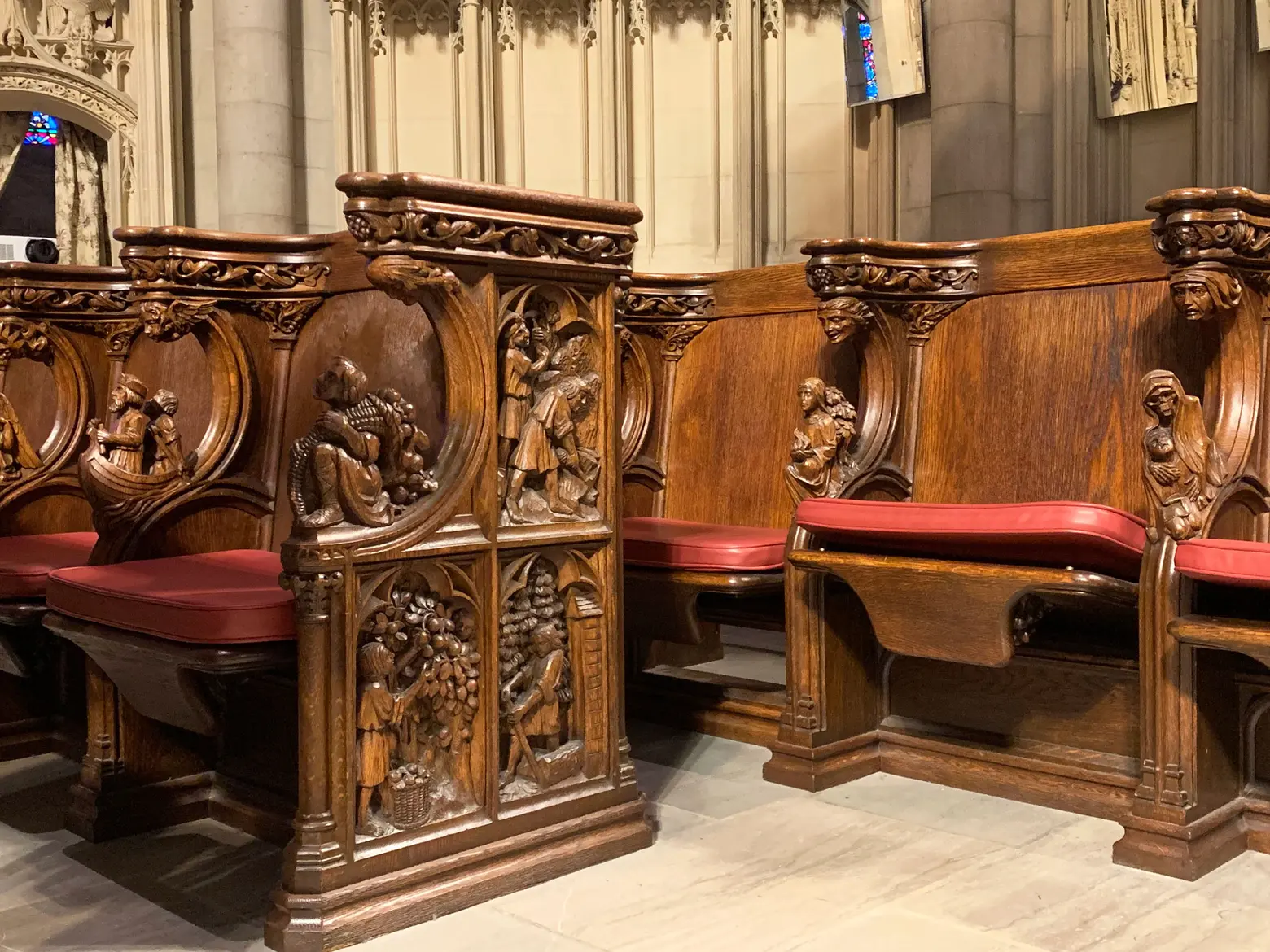
The choir sits on either side of the altar on the chancel.
On the floor of the chancel, there is a labyrinth that was adapted form the maze at Chartres, according to the church. On either side of the altar, the five choirs of the church sit in stalls made of oak. The Nave also features more than 30 stained glass windows with various religious themes, as well as non-Christian images.
The back wall of the chancel features an ornate stone screen representing “seven phases of Christ’s ministry” with Christ in the center. Historic secular figures, like Abraham Lincoln and Booker T. Washington, surround Christ from various fields, including the physician, the prophet, the teacher, the humanitarian, the missionary, the reformer, and the lover of beauty.
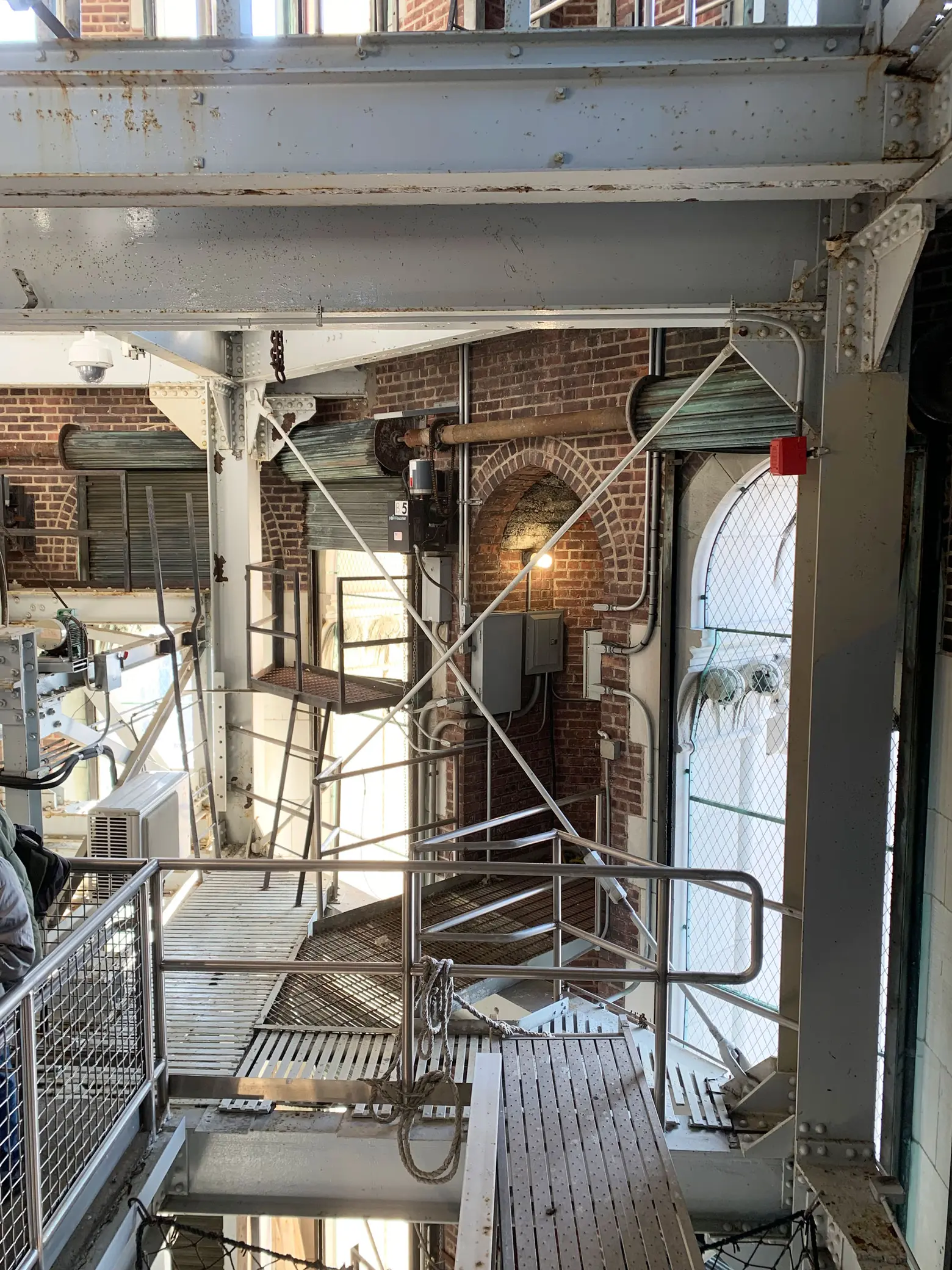
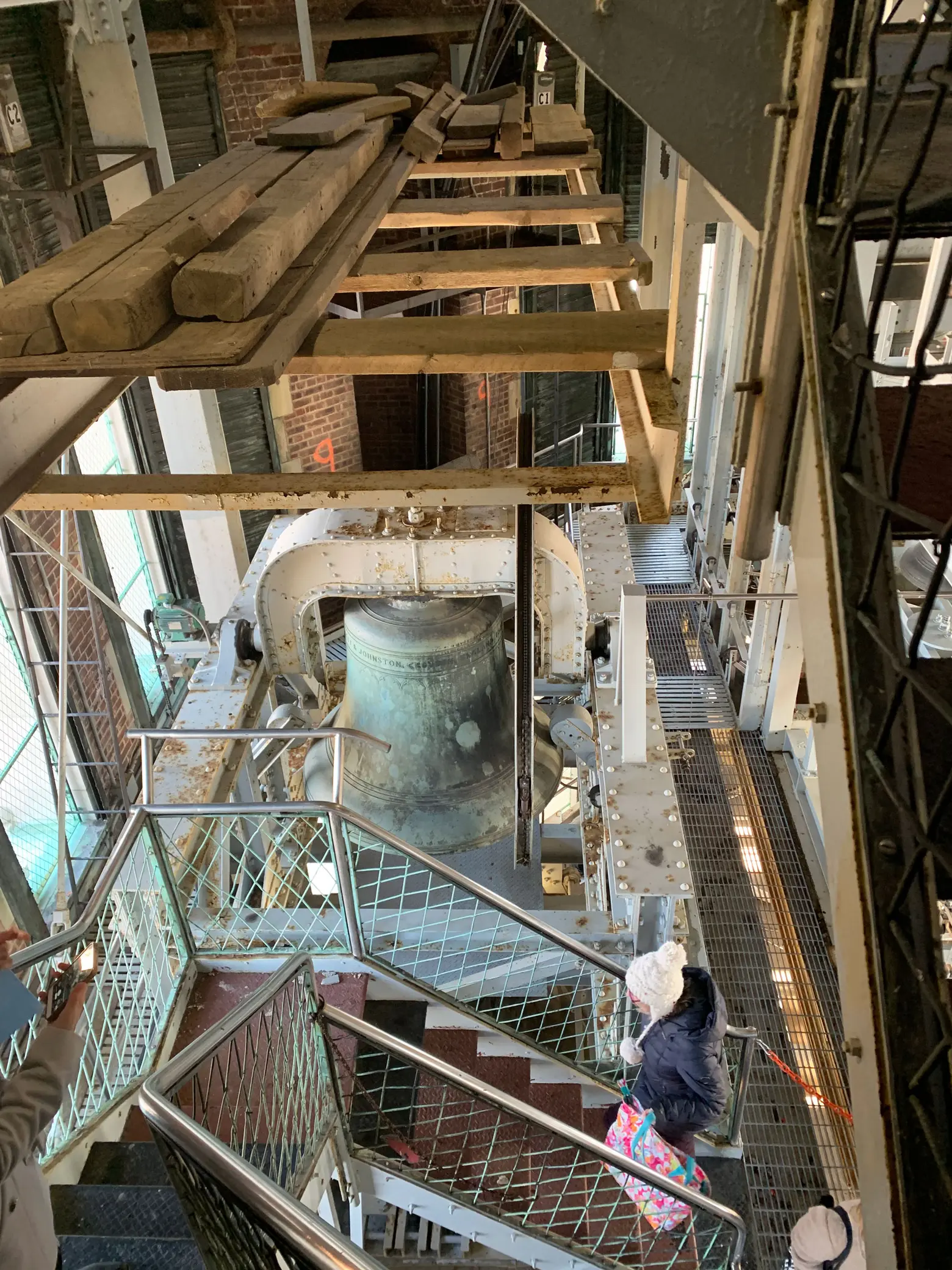
Visitors must climb 145 steps to get to the church’s penthouse gallery
The next stop on the tour is the carillon tower, named in honor of Rockefeller’s mother, Laura Spelman Rockefeller. Because the church was built on one of the city’s highest points, the top of the tower is roughly equivalent to more than 60 stories. The tower contains 80 offices and classrooms but was really constructed to hold the carillon, the bell chamber, and the observation deck.
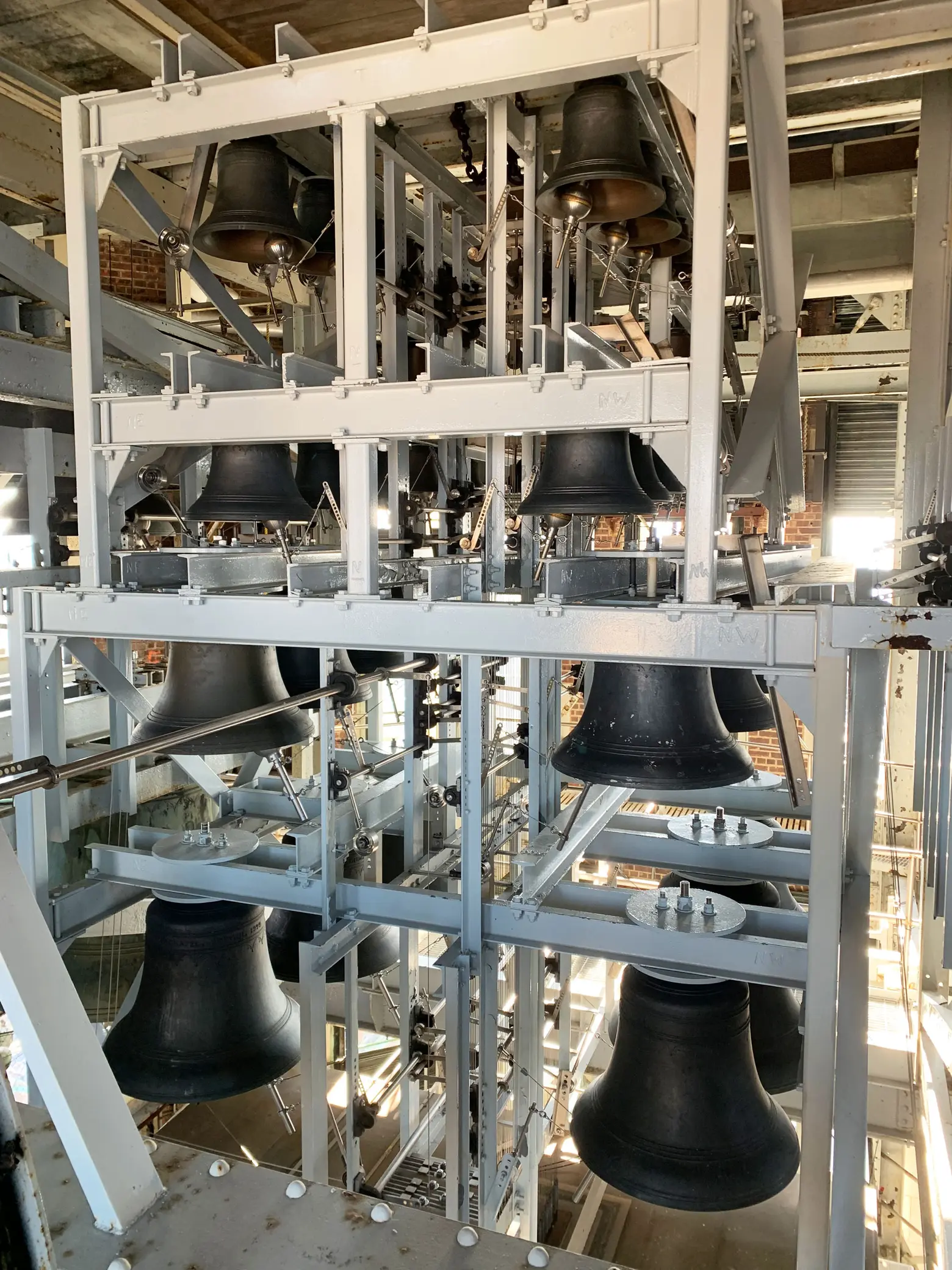
Guests must take an elevator (decked out with Freemason symbols) to the 20th floor and climb the remaining six flights of stairs. Fifty-three of the carillon’s 74 bells were made by the Gillet and Johnston foundry in England originally for the Park Avenue Baptist Church.
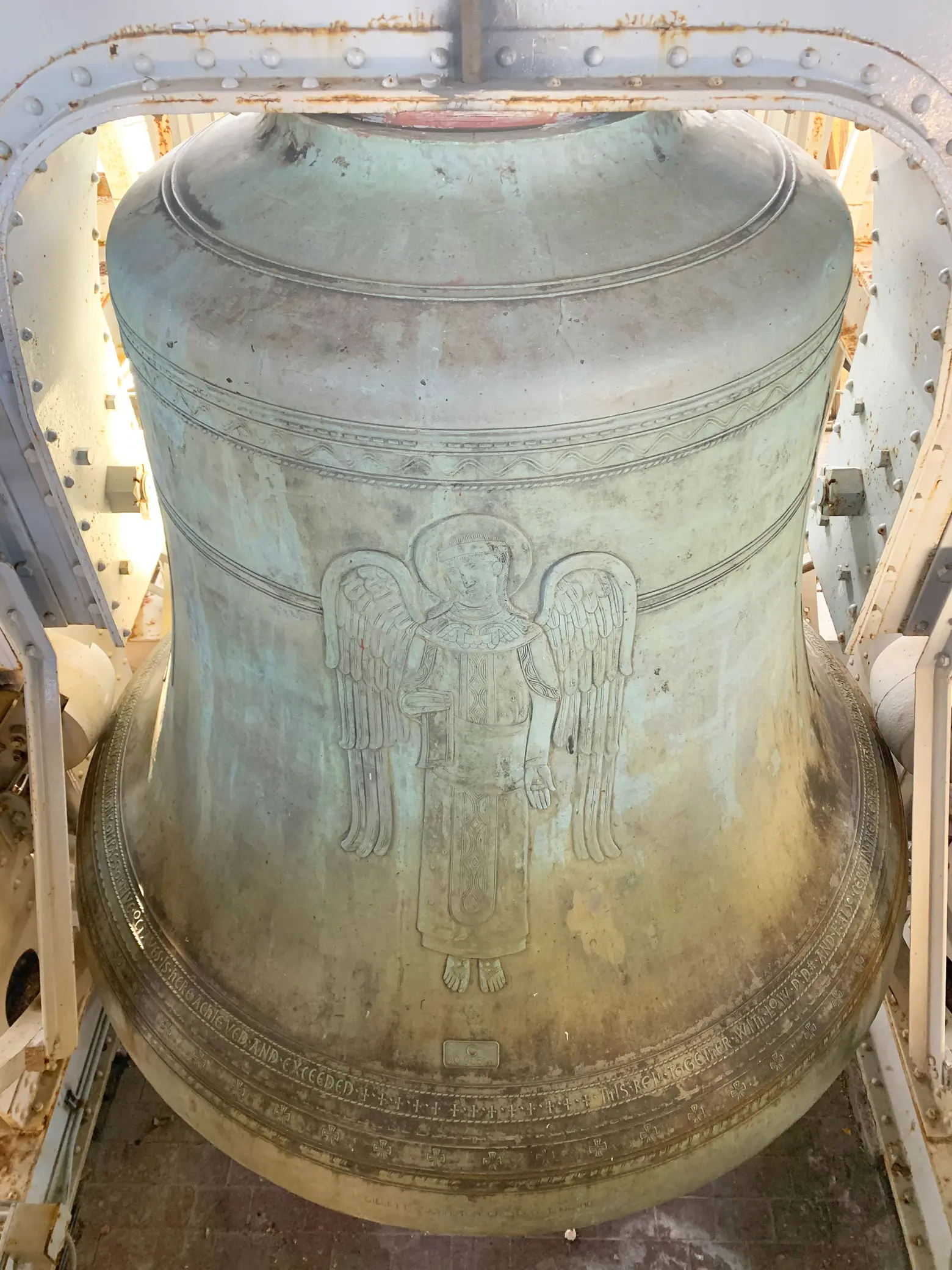
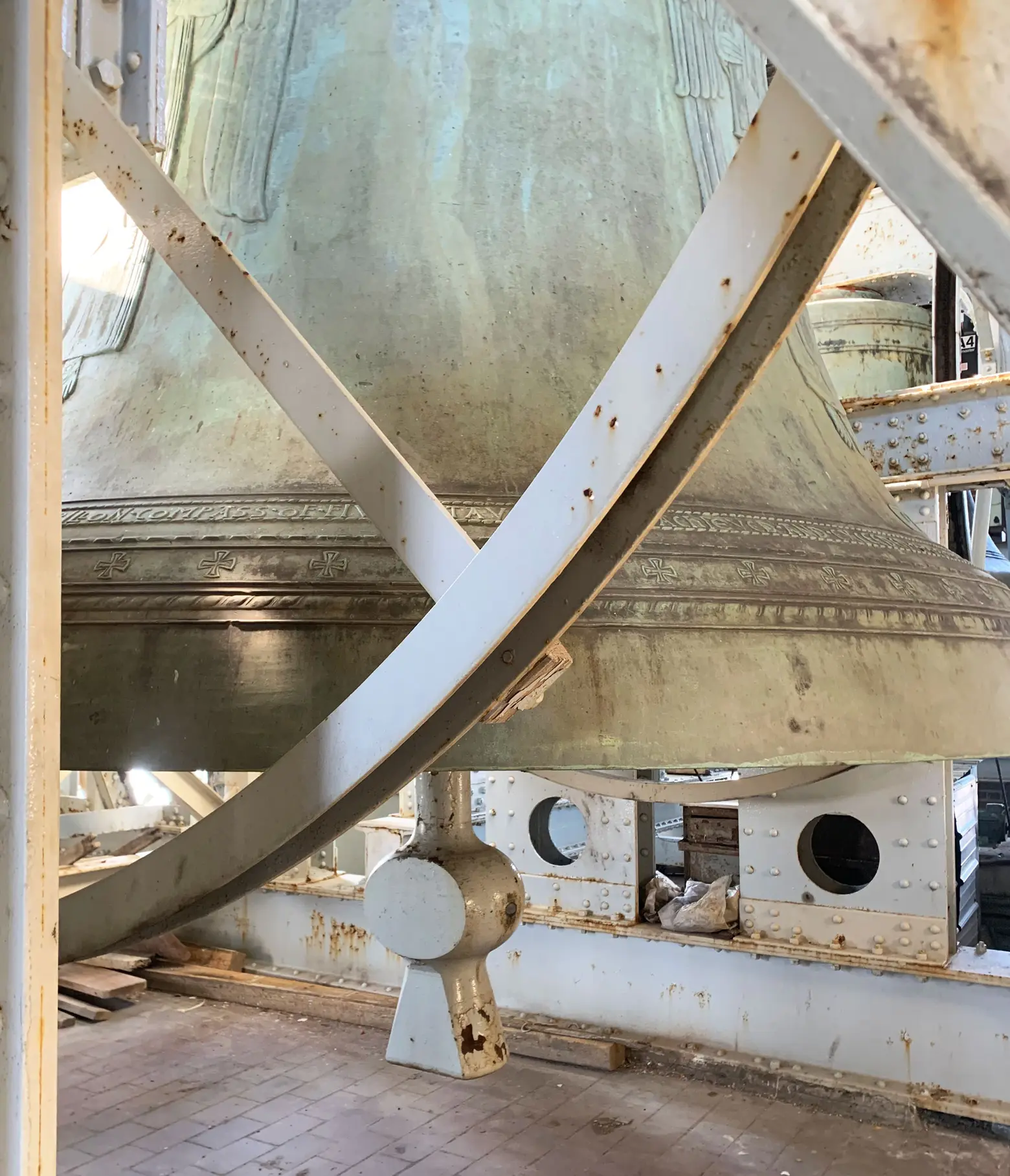
The Riverside Church’s Bourdon bell weighs 20-tons and is the largest tuned bell in the world
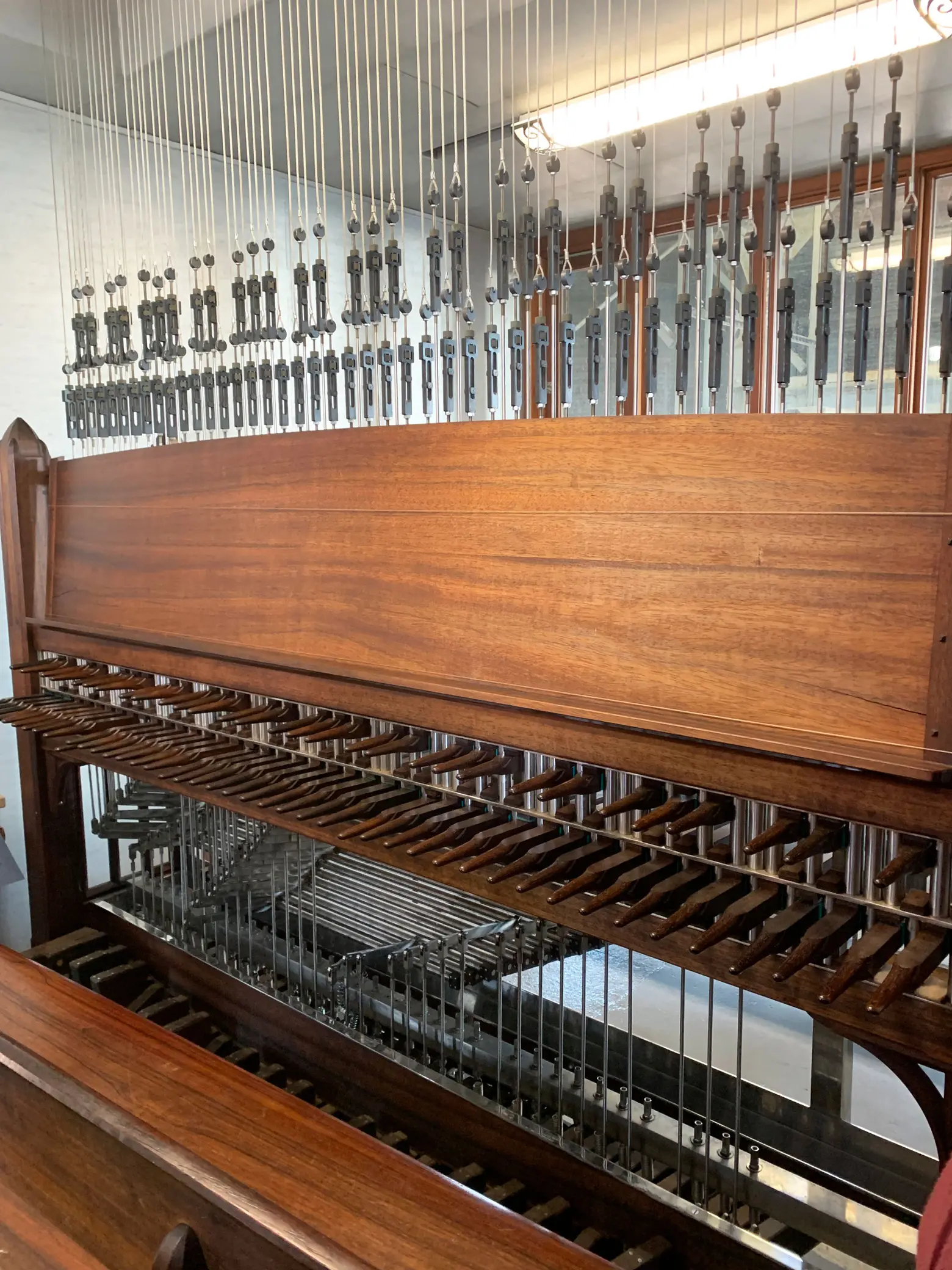
The carillonneur sits in the glass-walled “clavier cabin” beneath the bells.
The 20-ton Bourdon bell remains the largest and heaviest tuned bell in the world. Located within a three-floor belfry, the 74 bells are said to weigh more than 500,000 pounds together. Beneath the bells, the carillonneur sits in the glass-walled “clavier cabin” and plays by hitting the instrument with closed fists and pressing foot pedals.
In addition to the impressive size and sound of the tower’s bells, the 360-degree views are unbeatable. From the church’s peak, visitors can now enjoy a new perspective from Morningside Heights, overlooking the Hudson River and Grant’s Tomb, stretching up to the Bronx, down to Lower Manhattan, and westward to New Jersey.
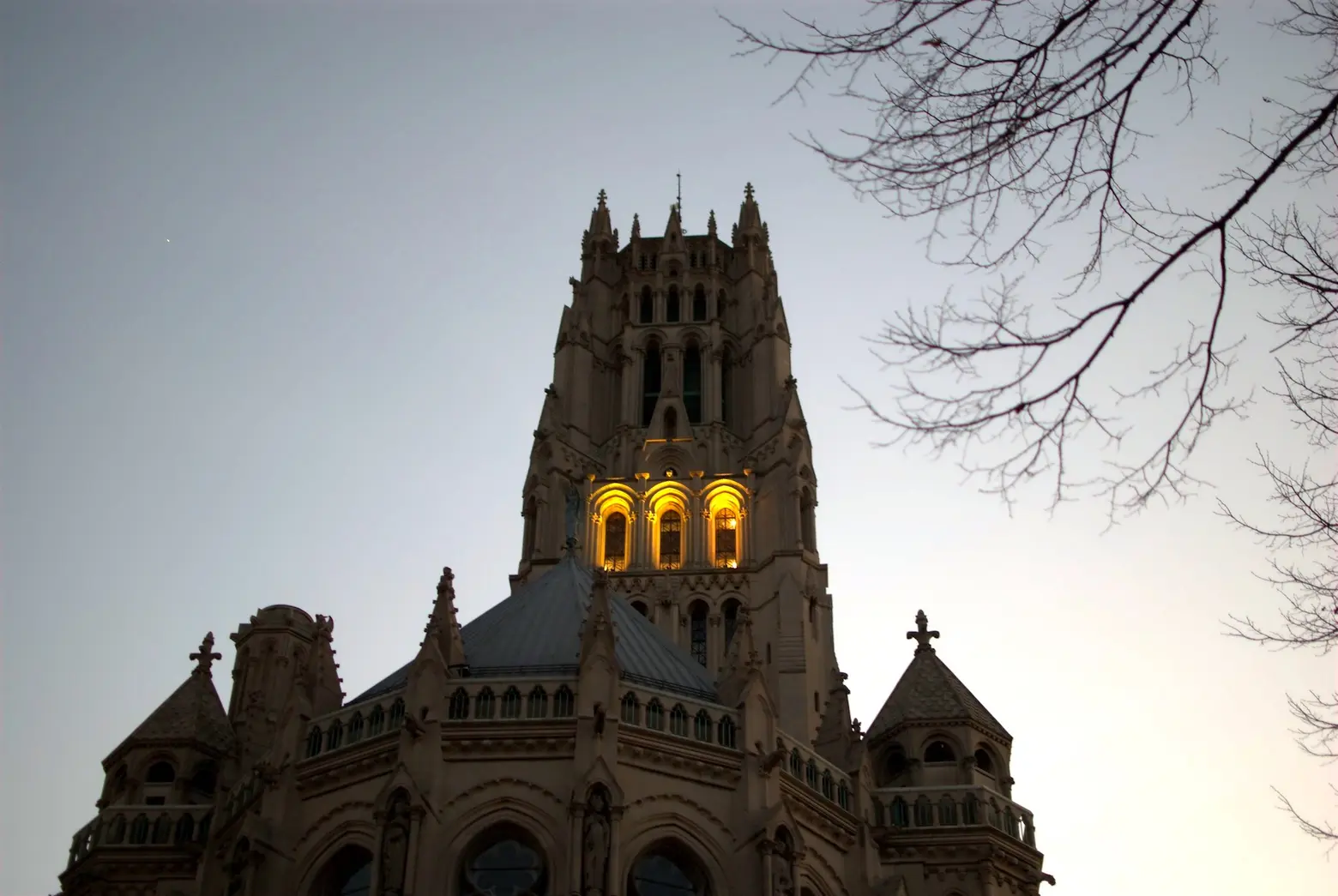
The bell tower at dusk; Photo by Joseph Bylund on Flickr
In its 2000 designation report, the Landmarks Preservation Commission described the Riverside Church as one of New York’s best known religious structures. The commission said the church “has a special character and a special historical and aesthetic interest and value as part of the development, heritage, and cultural characteristics of New York City.”
As both a place of faith and for progressive community activity, the church became a hub for social change, activism, and inclusion. Since the beginning, the church went against the grain, including when Fosdick spoke against the second World War II, elected its first black beacon in 1950, and became a major part of the civil rights and anti-war movements of the 1960s.
In 1967, Reverend Martin Luther King, Jr. gave his famous “Beyond Vietnam: A Time to Break Silence” speech at the Riverside Church, exactly one year before he was assassinated. The church, one of the first to perform civil union ceremonies, has also advocated for LGBTQ equality, through its ministry Maranatha. Founded more than 30 years ago, the group works with members of the LGBTQ community through special events and service projects. Other ministries of the church aid asylum-seeking immigrants, fight climate change, and support those formerly incarcerated.
For those unfamiliar with the impressive history of the Riverside Church, the reinstated bell tower tours provide the best overview of the church’s last 90 years. The tour includes a history of the church and a look at the Nave sanctuary, as well as the outdoor penthouse gallery with views of the carillon on the way to the top. The church also offers an art and history-focused tour to highlight the stunning architecture of the space, from the stained glass to seasonal exhibits. Get more details about the tours and purchase tickets here.
Photos © 6sqft unless otherwise noted
